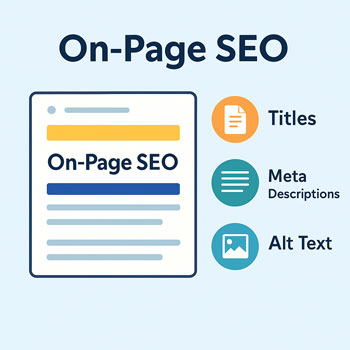
On-Page SEO (Titles, Meta Descriptions, Alt Text)
Learn the essential on-page SEO elements that help search engines understand your content and help users find what they need quickly.
What You’ll Learn
- How to write strong title tags that improve rankings.
- How to write compelling meta descriptions that boost clicks.
- How to craft effective image alt text for SEO and accessibility.
- How to implement all three in WordPress + Elementor.
What Is On-Page SEO?
On-page SEO focuses on optimizing the content and HTML elements on your website so search engines can better understand what your page is about.
This includes your page titles, headings, meta descriptions, internal links, image alt text, and overall content structure.
The 3 Core On-Page SEO Elements
-
Title Tags
The title tag is the clickable headline that appears in Google search results. It signals the core topic of your page.
Best Practices:
- Include your primary keyword once.
- Keep it under 55–60 characters.
- Add your city/location for local SEO (if relevant).
- Use your brand name at the end if space allows.
Examples:
- “Website Design for Small Businesses | BrightPixel Studio”
- “Emergency Roof Repair in Dallas | RapidFix Roofing”
-
Meta Descriptions
The meta description is the short summary that appears under your title in Google. It doesn’t directly affect rankings but increases click-through rate.
Best Practices:
- Keep it 150–160 characters.
- Include your keyword naturally.
- Highlight benefits or key information.
- Include a soft call-to-action.
Examples:
- “Affordable web design for small businesses. Fast, modern, and built to convert. Get your free quote today.”
- “Need emergency roof repair in Dallas? Fast service, fair pricing, and trusted professionals. Call now.”
-
Alt Text for Images
Alt text describes an image for search engines and for users with screen readers. It should be accurate and descriptive.
Best Practices:
- Describe what the image shows—not more, not less.
- Use keywords only if they naturally fit.
- Avoid stuffing keywords or writing full sentences.
Examples:
- Good: “web designer working on laptop”
- Good: “Dallas roofing team repairing shingles”
- Bad: “best web designer website design web designer small business”
Additional On-Page SEO Tips
- Use only one H1 per page (your main headline).
- Use H2s and H3s to organize content and improve readability.
- Use internal links to guide visitors to related pages.
- Avoid keyword stuffing—keep copy natural and helpful.
- Keep paragraphs short for better readability.
How to Apply This in WordPress
- Install an SEO plugin (Yoast, Rank Math, or AIOSEO).
- Open your page → scroll to the SEO preview box.
- Add your title tag using best practices above.
- Write your meta description (Google preview updates instantly).
- Edit images → click → fill in the “Alt Text” field.
- Update your headings to follow a clean H1 → H2 → H3 structure.
Mini Exercises (10–15 Minutes)
- Rewrite your homepage title tag using the 60-character rule.
- Create a compelling meta description using benefits + call-to-action.
- Update alt text for 3–5 images on your site to be more descriptive.
On-Page SEO Checklist
- Unique title tag for each page.
- Clear, helpful meta description.
- Accurate image alt text.
- Logical heading structure (H1–H3).
- Internal links to related content.
- No keyword stuffing.
